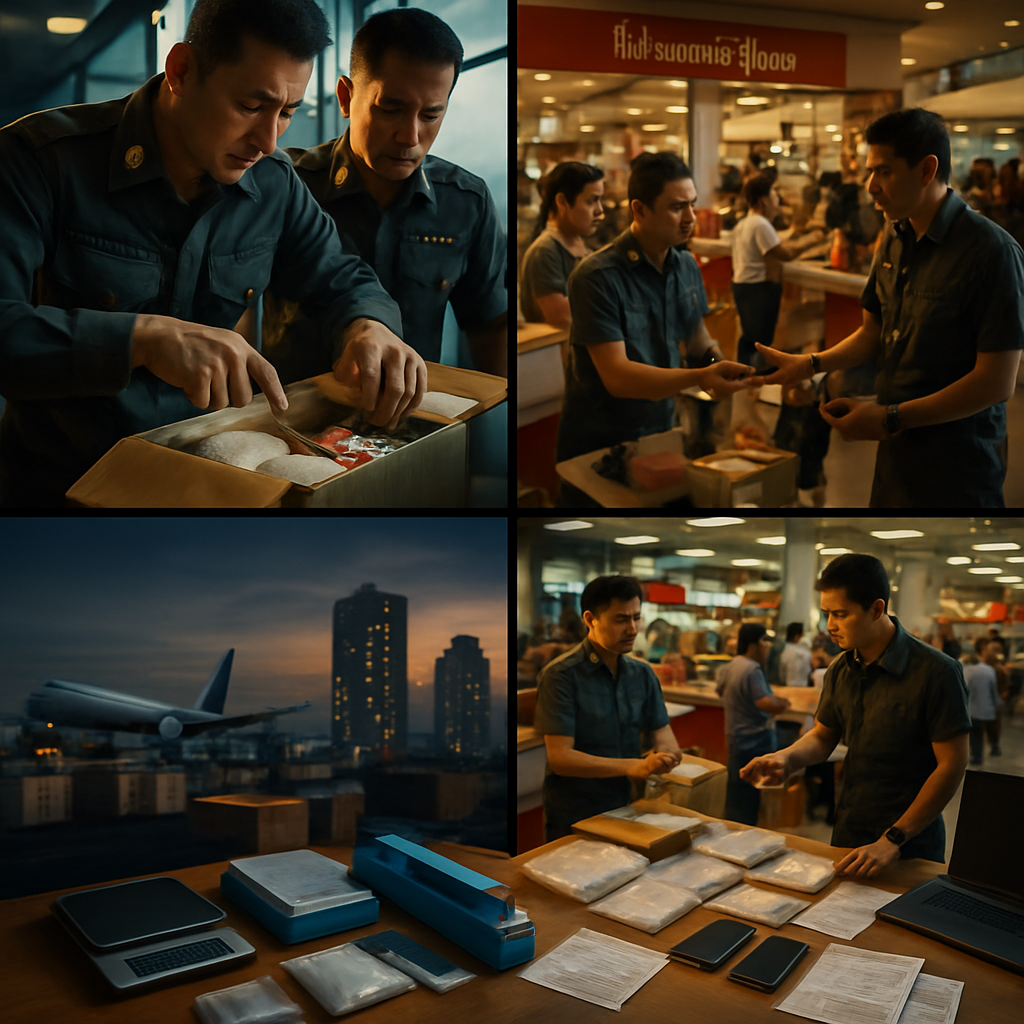Thai narcotics agents pulled off a cross-border sting that reads like a modern crime thriller — only this time the plot unfolded amid cardboard boxes, postal counters and luxury condominiums. In a coordinated crackdown, officers from the Office of the Narcotics Control Board (ONCB) and the Airport Interdiction Task Force (AITF) dismantled a trafficking network that had been using cleverly concealed parcels to ship heroin from Bangkok to Australia.
Suspicious parcel at Suvarnabhumi sparks fast-moving probe
The operation began where many international schemes do: at the airport. AITF officers inspecting outbound parcels at the Suvarnabhumi Airport Free Zone noticed something odd about one cardboard box bound for Australia. When they opened it, they found a hidden compartment — and inside, 1.52 kilogrammes of heroin.
That single seizure triggered an immediate investigation aimed at finding who had packaged and shipped the drugs. What followed was a rapid series of arrests and raids across Bangkok and nearby Samut Prakan that revealed an organised, multilingual effort to move hard drugs overseas.
Post office sting in Lat Phrao: lookouts and copycat concealment
Working on intelligence from the airport discovery, ONCB and AITF officers moved to a shopping mall post office in Lat Phrao. There, two Vietnamese men were intercepted as they tried to send additional parcels using the same concealment technique. Officers seized another 1.4 kilogrammes of heroin from those packages.
The sweep didn’t stop there. Two more Vietnamese suspects who had been acting as lookouts in the mall were arrested, bringing the number of detained Vietnamese nationals in this phase to five. With arrests in hand, investigators widened their net to locations tied to the suspects.
Raids uncover a cocktail of drugs and packaging gear
Searches at three properties in Samut Prakan and Bangkok turned up a substantial cache:
- At a condominium in Samut Prakan officers found 2 grammes of ketamine.
- At a condominium in Bang Na, another Vietnamese national was arrested and a large haul was seized: 75 grammes of ketamine, 107 grammes of crystal meth (methamphetamine), 1.7 kilogrammes of MDMA, 309 ecstasy pills, 230 grammes of cocaine and 380 grammes of nimetazepam.
- The third location — a rented room in Lat Phrao — yielded no illegal items.
Investigators also recovered packaging equipment commonly used to prepare shipments: digital scales, sealing machines, parcel receipts, multiple mobile phones and a laptop. Those items paint a picture of an operation that combined local logistics with international intent, using small-scale hideouts to package high-value consignments for export.
Separate Yakuza-linked arrests deepen the web
In a related but distinct operation, ONCB officers arrested two Japanese men in Bangkok on November 22. Authorities said the pair were linked to a transnational trafficking ring connected to a Yakuza network, accused of smuggling drugs to South Korea. A South Korean suspect related to that scheme remains at large.
While investigators have not publicly confirmed a direct operational link between the Vietnamese parcel-smuggling group and the Yakuza-connected network, the proximity of arrests and the international shipping routes involved underline how porous global drug supply chains can be — stretching from inner-city condominiums to international mailrooms and beyond.
What this means for international smuggling and local enforcement
The case highlights several important trends: traffickers are increasingly exploiting postal and parcel services to move large quantities of synthetic and hard drugs; concealment methods are becoming more sophisticated; and cross-agency coordination — in this instance between ONCB and AITF — is essential to intercept shipments before they reach foreign markets.
For travellers, postal clerks and logistics companies, the operation is a reminder to stay vigilant for unusual packaging and suspicious parcel behaviour. For law enforcement, it’s an encouraging example of speed and coordination preventing kilos of heroin from entering international distribution channels.
As the investigations continue, authorities say they will pursue remaining leads and international collaborators. With arrests made and hundreds of grams of illicit drugs off the streets — and out of the air freight network — Thai agencies are sending a clear message: when boxes start to look too clever, someone will be looking back.


















This sting reads like a movie, but with real-world consequences — kilos of heroin intercepted before they hit Australia. The coordinated work between ONCB and AITF shows how intelligence plus routine checks can disrupt sophisticated smuggling. I’m following this closely because the international angle and the Yakuza mention suggest bigger networks at play.
Cool story, but why always blame foreigners? Shipping routes are just logistics, not some cultural conspiracy. If they can ship it out of Bangkok, someone in the receiving country is buying it too.
I hear you, grower134, but reporting names and nationalities is part of the facts; it’s not about scapegoating. It’s also true that transnational rings exploit migrants and enclaves, and enforcement has to target networks rather than communities. Still, public conversation should avoid xenophobia while demanding accountability.
As someone who studies transnational crime, it’s important to distinguish between nationality and organized-crime structures; networks recruit opportunistically. Pointing to Vietnamese nationals or alleged Yakuza links is empirical, but policy must avoid ethnic profiling.
Fine, but sympathy only goes so far when kilos of heroin show up. Accountability matters more than nuance in the headlines.
Agreed on accountability, but nuance affects policing outcomes and community cooperation, which are critical to preventing future smuggling.
Drugs are bad. People suffer, families too. Good police work stops some bad guys.
The operational detail about hidden compartments and parcel receipts is telling: this was a learned technique, possibly shared across cells. Tracking the procurement of sealing machines and scales could yield upstream suppliers. International AML and mail-security protocols need to adapt quickly.
So we chase machines instead of money trails? Sounds like theater. Arresting a guy with a scale doesn’t collapse a cartel. Follow the banks and the couriers.
Both approaches matter: physical interdiction removes product and tools, while financial investigations dismantle the network. They’re complementary, not theatrical.
From a criminology perspective, convergent strategies are best. Seizures create intelligence that helps map networks, which then allows financial and legal levers to be applied internationally.
If parcel services get more checks, my online shopping will slow down. Are we willing to sacrifice convenience for security? I worry about overreach and delays.
Tiny inconvenience is worth preventing heroin hitting communities. The alternative is more addiction and death, which slows everything worse than 24-hour delays.
There should be a balance. Randomized checks and intelligent risk profiling can minimize delays while maximizing interceptions.
Risk profiling often targets certain countries and packages, which can be biased and easily gamed by criminals.
This case is an excellent example of how globalization facilitates illicit markets: cheap air freight, porous borders, and parcel anonymity. The mention of both heroin and MDMA in different locations suggests diversified production or mixed supply chains. Australia as an endpoint shows demand patterns that need addressing domestically as well.
Exactly — you can’t only police supply. Australia and South Korea are consumers in this story, and demand reduction programs are underfunded relative to interdiction budgets.
I’m curious whether Australian authorities will trace links and pursue arrests on their end, or if this will mostly be a Thai story. Cross-border legal cooperation is critical here.
Demand reduction is a nice phrase, but too many politicians prefer visible busts to the boring work of social services.
Why do they send drugs in boxes? That sounds easy to spot. Are they dumb or just lucky sometimes?
Concealment in everyday items is effective because it blends in. It’s not about being dumb; it’s about exploiting routine assumptions by postal workers and algorithms.
I’m skeptical of the ‘Yakuza link’ headline. Names like that are flung around to make stories exciting. Without concrete evidence, it’s just conjecture. Media and police both benefit from dramatic labels.
I agree we should be cautious, but law enforcement indicated potential ties to transnational rings, so it’s worth investigating rather than dismissing. Labels can be misleading but also sometimes accurate.
Even if Yakuza aren’t involved, the style of operation—fragmented cells, mail routes—resembles transnational organized crime playbooks.
Seizing 1.52 kg in one box and then another 1.4 kg shows significant export ambition; those are quantities that attract major players. The discovery of multiple drug types at Bang Na suggests either multiple clients or a distribution hub. Law enforcement should prioritize linking digital footprints from mobile phones and parcel receipts to upstream distributors.
They found phones and a laptop; metadata can be a goldmine if agencies can access backups and cloud logs. Cross-border data requests are the bottleneck, not tech.
But privacy laws and encryption can hamper investigations. There needs to be a legal framework to quickly get data in serious cases without normal delays.
True, but international letters rogatory and mutual legal assistance treaties exist; they just require political will and speed.
This sounds like the plot of a Netflix show. Condos, lookouts, hidden compartments — very cinematic. But the human cost is real, not entertainment. I want to know who the buyers were.
I’m trying to find follow-up reporting on buyer networks and whether any recipients in Australia were intercepted. I’ll post updates if I get them.
Also, why are migrants always the ones falling into these stories? Could be exploitation, or could be opportunistic crime. Either way, the social dimension is missing from headlines.
Both points matter: migrants can be victims of coercion, and socio-economic marginalization can make them susceptible to recruitment. Policy must be humane and smart.
From a research angle, what I’d like to see is network analysis of seized communications, parcel routes and payment channels. That will answer whether this is a localized cell or part of a larger syndicate. Quantitative data beats speculation.
Agreed; open-source shipment tracking and receipt patterns can be used to build probabilistic models that flag suspicious consignments before manual inspection.
Models are great, but you still need boots on the ground to execute raids and make arrests. Tech can’t replace fieldwork.
Hats off to ONCB and AITF. They stopped heroin from reaching streets and likely saved lives. We should be praising the coordination rather than nitpicking methods.
Praise is fine, but accountability is crucial too. Were proper legal processes followed during raids and arrests? Transparency builds trust.
Mail inspection raises civil liberty questions. Are there safeguards to prevent arbitrary searches of private parcels? Transparency about protocols is essential. Random checks should be limited and supervised.
Agreed — while most countries allow customs and law enforcement to inspect international mail, oversight and clear criteria are important to prevent abuse and profiling.
And those criteria are often secret, which is precisely why people get nervous. Accountability needs teeth, not just press releases.
The Yakuza mention is the most intriguing part for me. If true, this indicates diversification into postal smuggling and could signal a shift in organized crime tactics. It merits international task force attention.
Yakuza historically prefer cash-intensive businesses, but globalized criminal networks adapt. Cooperation between East Asian syndicates and Southeast Asian cells is plausible and worrying.
What about workers at the post office? They might be threatened or bribed. We need protections and whistleblower channels. People on the front line deserve safety.
Yes — and training for postal staff to recognize odd packaging would help. This isn’t just law enforcement’s job.
I’m torn: I want strong interdiction, but I’m worried about racial profiling and innocent people being harassed. How do we thread that needle? Community outreach and oversight sound basic but are ignored.
Community engagement, legal oversight, and data-driven targeting are the triple helix that can minimize harm while maximizing effectiveness.
If you think about it, parcels are the perfect vector: cheap, deniable, and routine. As e-commerce grows, this problem will too. Logistics companies must invest in detection tech.
Agreed. AI-powered anomaly detection on package dimensions, weight mismatches and sender-recipient reputational scoring could catch more shipments earlier.
Private companies should cooperate with law enforcement but with legal safeguards. It’s a partnership, not a surveillance free-for-all.
The mixture of drugs found suggests they’re hedging bets across markets. That makes it more profitable and riskier to track. Dealers diversify to reduce single-market exposure.
Diversification also complicates enforcement because different substances implicate different supply chains and producers. It requires multi-disciplinary policing.
Someone should ask why Australia is a chosen destination. Is it law enforcement gaps, demand, or shipping convenience? We need a broader regional strategy, not just arrests.
All three. Destination choices reflect market demand, perceived enforcement risk, and logistical cost. Regional cooperation and demand-side policies can alter those calculations.
I worry small-time couriers get the worst punishment while bosses stay remote. The system still incentivizes catching those at the bottom. Where are the kingpins?
That’s a perennial problem. Intelligence from seizures and phone records should be used to escalate investigations to higher levels if possible.
And political will to pursue leaders across borders — that’s the missing ingredient most of the time.
I live near a postal hub and I’m nervous now. Are local neighborhoods at risk of being surveillance targets? Can agencies reassure civilians? Communication matters.
Law enforcement often meets local communities after operations to explain actions, but public trust varies. Agencies should proactively publish anonymized summaries to ease concerns.
Legal prosecution will be interesting. Will court records reveal more about the network or will most evidence be sealed for security reasons? The justice transparency trade-off is complex.
Courts balancing operational secrecy and public right to know is always messy. Oversight bodies should audit these cases post-conviction.
Also worth noting: ketamine, MDMA, meth, cocaine — the variety points to both local consumption and export. This isn’t just heroin for export; it’s an ecosystem of illegal trade.
Yes, and that ecosystem will reroute if one channel is closed, so continuous intelligence and adaptive strategies are necessary.
Which is why international cooperation and shared databases are essential. No country can tackle these networks alone.
The human cost should be front and center. Arresting couriers might reduce supply briefly, but what about rehabilitation and victim support? Too little balance there.
Absolutely — enforcement should be paired with public health measures. I’ll look into whether Thai authorities coordinate with health services in these operations.